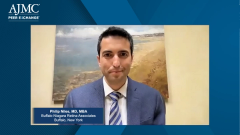
Role of Faricimab in the Management of Wet AMD
Philip Niles, MD, MBA; Nicholas G. Anderson, MD; and Kevin U. Stephens, Sr., JD, MD, explore the role of faricimab in the current treatment landscape for wet AMD.
Episodes in this series

Jim Kenney, RPh, MBA: There’s another interesting product, it’s a bispecific antibody, faricimab. It has activity for both angiopoietin-2 and VEGF-A pathways in the eye. Where do you see this drug fitting into the current landscape for wet AMD [age-related macular degeneration]?
Philip Niles, MD, MBA: Yes, it’ll be interesting to see how well faricimab is utilized. I think it could have a very large role. The goal of faricimab right now, in it’s maximum best-case scenario, is to go to Q [every] 16 week dosing, which is a very long time. They did that after just a loading period for some patients. That has a lot of us very optimistic about where things could go for that. It’s very much like the Beovu [brolucizumab] situation, where until the drug is actually in our hands and used, accepted, and found to be safe, I think everyone’s going to be a little more gun-shy about something new to come out. I also think there’s going to be this disparity between the pivotal trials and the in-practice use, and we’ll have to figure that out as we go.
Nicholas G. Anderson, MD: I agree completely. I’m very excited about the product. I’m also very interested to see the real-world data. We’ve seen in the past some hope for more extended durability that didn’t really come to pass in actual practice. Hopefully, this one’s for real.
Jim Kenney, RPh, MBA: Are there any capacity constraints on your practices in terms of patients being able to get in to be treated with the current therapies? Would a product like this open up capacity to see more patients who maybe are having difficulties getting appointments or getting in to be seen?
Nicholas G. Anderson, MD: Well, it’s a great question. It’s an important question. I would say that we don’t necessarily have a capacity constraint in the workplace. My capacity constraint is getting back home in time for dinner and to help the kids with homework because as we see more patients and more injections, all of us are just spending more time at work. We’re all certainly willing to do whatever it takes to take care of patients. We do tend to focus on the patient side, and appropriately so, in decreasing that burden. But the health care system can only take so much. It takes a very long time to train a retina surgeon, and we’re not swamped with graduates coming out, so all of us are working pretty hard right now.
Philip Niles, MD, MBA: Just like you said, I think there are certain capacity constraints in particular geographies. There are some really underserved communities right now. And a lot of us are just trying to get through that. I think there are a lot of universities that are trying to make do with the faculty they have when really they could use a few more people. There are certain rural geographies that could probably use another retina specialist or 2, and there are probably a lot of places like that. Like you said, we are spending more hours in the clinic. But I think there are major access-to-care issues, particularly with diabetic macular edema right now.
Nicholas G. Anderson, MD: When we talk with payers, one thing we always look at is the future. Again, it takes a long time to train a retina surgeon. It’s a rigorous field. A lot of younger physicians really aren’t looking for that lifestyle anymore. But if you look at the absolute booming numbers of diabetics in United States, the graying of the population, we always say there’s a tsunami of patients coming down the pike. How do we prepare for that? It’s certainly a challenge in the short to medium term.
Kevin U. Stephens, Sr., JD, MD: I think that’s a very good point Dr. Anderson just made. We focus a lot of time on treatment, and we don’t do nearly as much as we should or could do in terms of prevention. If you look at obesity, diabetes, and so forth, the prevalence and incidence have come up and up and up, and we are living longer. So we are living longer with more chronic diseases, and you’re going to have a greater severity of illnesses and complications from the diseases because you’re living longer. I think we do have to look at our public health and strengthening the public health infrastructure, information, and management, so that people can have more tools to detect diabetes early and manage it so that they don’t have all these outrageous blood sugars and those things. We have a lot of work to do on so many different aspects of this, so this is very important.
Nicholas G. Anderson, MD: Absolutely, I agree. An interesting data point is that simply reducing the hemoglobin A1C by 1 point, so going from a 10 to a 9 or an 8 to a 7, potentially decreases the future treatments in a patient with diabetes by 50%. So I’m always trying to be very encouraging to my patients. A patient may say, “Well yes, I went from a 9 to an 8. It’s really not that big of a difference.” It’s a huge difference. Anything that we can do, and again, here I think is a great example of where we can collaborate with the payer groups to get ahead of this and get the diabetes under control. This will have a huge impact on cost down the road.
Transcript Edited for Clarity
Newsletter
Stay ahead of policy, cost, and value—subscribe to AJMC for expert insights at the intersection of clinical care and health economics.





























































